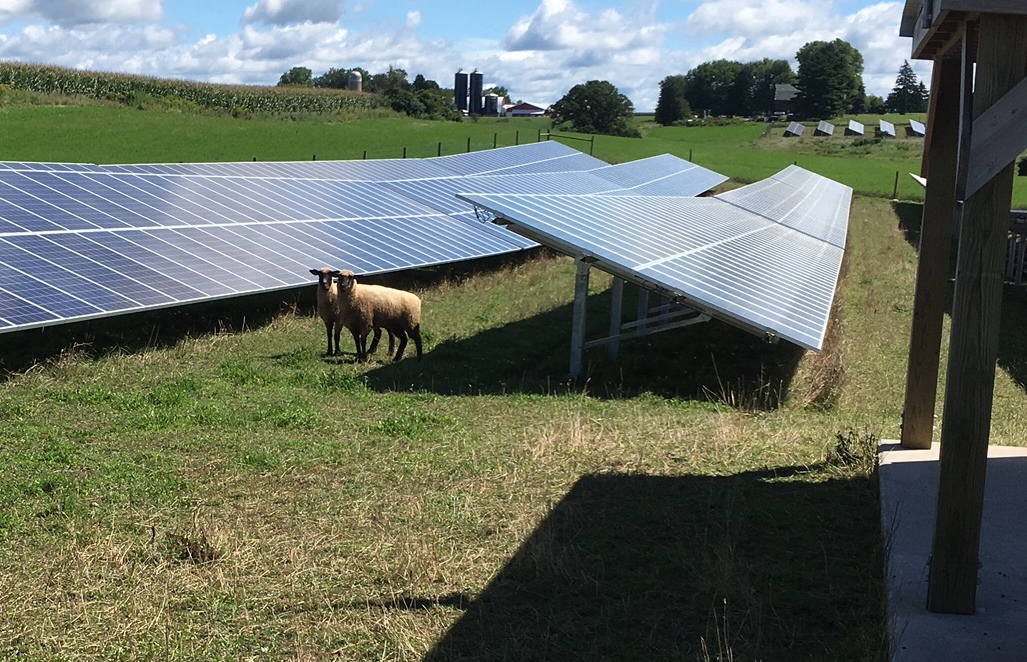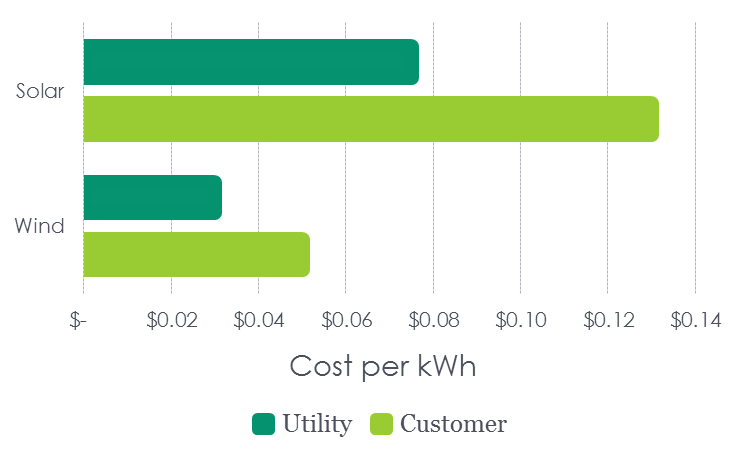
The June issue of Public Utilities Fortnightly (PUF) featured a supplemental, special report in collaboration with Navigant Research. One of the interesting articles in that publication is Impacts, Threats, Opportunities of renewable energy production. It compares utility scale to distributed renewable power generation.
To refresh your memory, or perhaps for new subscribers, see my post on the Bogus Energy Internet of Things where I describe, in relatable terms, that distributed dinky power supply compared to the grid makes very little to no sense. The PUF/Navigant article backs this with the prices of wind and solar renewable energy generation for distributed (customer) and utility-scale sources.

The article doesn’t say whether this is before or after subsidies. The objective of the graphic is to show the difference in utility-scale versus distributed (customer) generation for both wind and solar. Utility-scale renewables can, for all practical purposes, be distributed as well, just not in 2 kW increments from house to house. Rather, it may be a megawatt of solar fields on the edge of town.
Subsidy Break
By the way, I would like to mention that the problem with subsidies is they never go away, except for those in efficiency programs. For energy efficiency, we have incentives until this thing called market transformation occurs. For example, incentives for appliances have been driven out of existence because it is no longer cost effective to throw money at people purchasing these things.
Not so with renewable energy. The hamburger from those sacred cows is getting old, arthritic, gristly, tough, and dry on the bone. The utility executive[1] from the PUF article says “We need a twelve step program. We know we have a problem.”
Good luck with that.
The Cute Little Cub Grows
Who wouldn’t want one or two of these little fellas rumbling and tumbling around the house for entertainment and companionship? Aw. What a cutie. You’ll be saying aw [four letter word here] a year later when after slipping out the patio door while you’re hanging clothes out to dry, he later shows up with his trophy, Muffy, the neighbor’s dog.
For distributed generation, the lion cub is inexpensive and a blip on a cost scale of supplying pens and paper clips for the utility. As it grows, the costs become more like the cost of a fleet of those half million dollar utility rigs we’ve all seen. The net metering and interconnection costs become significant, and somebody needs to pay for it, and it won’t be the shareholders.
Utilities Should Steer
The PUF article implores utility executives to lead this restructuring.
Have you ever slid down a driveway on ice, or better yet, a long steep hill, or better yet, a long hill with something heavy in tow? If you jam on the brakes and hope for the best, it won’t end well. You will be beached in a snow bank, careen off a guard rail, or worse, over an embankment until a big tree or several of them bring the wreckage of what was your vehicle to a stop.
Rather, don’t panic. Keep the wheels turning in controlled decent. Rolling wheels can be steered to control the mass that is your vehicle and load.
In the case of utilities and distributed mom and pop energy, renewables are the load, and the utility must steer the mass. Utilities are the tractor that must stay ahead of the 60,000 pound mass pushing from behind, so as not to jackknife. In other words, utilities are being pushed, and therefore I would call it a controlled landing rather than leading (pulling).
I’ll bet this guy needed a fresh change of under garments after his adventure.
Reliability
You may recall that I contrasted cellular phones and batteries to the transformation of the customer-driven micro distributed generation rage (DG) last year in Distributed Energy – Batteries and Bread Machines. The utility executive in the PUF article states the telephone analogy only works to a certain point. “We have irrational economics for rooftop solar. Now we need to put in batteries to support it and further add to the disruption and cost.” “The grid now [with micro DG] becomes even more vulnerable.”
Touché.
The utility executives, and an economist for commissioners, say “utility-scale solar will always [my emphasis] be most economic”. Utility scale solar can include community solar, solar gardens, and solar farms – whatever plays well with the locals. Consider Vernon Electric Cooperative’s solar farm just a few miles from my home – protected by these savage Suffolk Sheep.
How about PV-covered parking lots? How much sense does that make? A lot. Consider the swath from Tucson up through Vegas and California’s central valley. Why not build utility-scale solar to cover portions of the thousands of acres of flat paved parking lots? Electric vehicles anyone? No need for inverters and rectifiers to go to alternating current and back for charging cars.

Utilities could partner with retailers and charge customers to park in the shade. I think it’s an easy bet that Phoenixers would pay a buck an hour simply to park their car in the shade on a 114 degree day. What’s not to like? Patent pending.
[1] Remains anonymous, presumably because speaking about shortcomings of customer owned renewables is not good PR.







